|
Chapter Three
REALM OF THE
SERPENT GODS
"When Tenochtitlan attained its greatness, the
Toltec capital of Tula had already been recalled as the legendary
Tollan. And when the
Toltecs had built their city, Teotihuacan was already enshrined in
myth. Its name has meant "Place of the Gods"; and that, according to
recorded tales, was exactly what it had been.
|

Pyramid of
Sun at night, Teotihuacan. Mexico
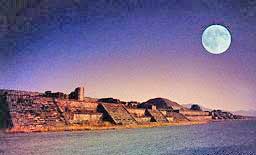
Pyramid of
the Moon and Plaza. |
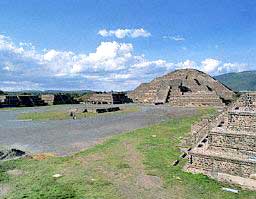
These
Pyramids are connected by the Avenue of the Dead, nearly
five straight miles long. |
"It is told that there was a time when calamities befell the
Earth,
and the Earth fell into darkness, for the sun failed to appear. Only
at Teotihuacan there was light, for a divine flame remained burning
there....
"....They (the concerned gods) asked for a volunteer to jump into
the flame, and by this sacrifice bring back the sun.... one of the
gods offered, but he lacked courage when facing the flame; another
god then jumped and the first, now shamed followed. "As the gods
were consumed, the Sun and Moon reappeared in the skies....
 "....The tale is intimately connected with
Teotihuacan’s most
renowned monuments, the Pyramid of the Sun and the
Pyramid of the
Moon
(click image right). One version has it that the gods built the two pyramids to
commemorate the two gods who had sacrificed themselves; another
version states that the pyramids had already existed when the event
was taking place, that the gods jumped into the divine fire from
atop preexisting pyramids. "....The tale is intimately connected with
Teotihuacan’s most
renowned monuments, the Pyramid of the Sun and the
Pyramid of the
Moon
(click image right). One version has it that the gods built the two pyramids to
commemorate the two gods who had sacrificed themselves; another
version states that the pyramids had already existed when the event
was taking place, that the gods jumped into the divine fire from
atop preexisting pyramids.
"Whatever the legend, the fact is that the
Pyramid of the Sun and
the Pyramid of the Moon still rise majestically to this very day....
Rising in a valley whose surrounding mountains act as a backdrop to
an eternal stage, the pyramids force the visitor’s eyes to follow
their upward slope, to the mountains beyond and the vista of the
skies above. The monuments exude power, knowledge, intent; the
setting bespeaks a conscious linking of Earth with Heaven. No one
can miss the sense of history, the presence of an awesome past.
"How far back in the past?.... the date keeps slipping back.... In
the 1950s a leading archaeologist, M. Covarrubias, incredulously
admitted that radiocarbon dating gave the place "the almost
impossible date of 900 B.C." (Indian Art of Mexico and Central
America). In fact further radiocarbon test gave a date of 1474 B.C.
(with a possible small error either way). A date of circa 1400 B.C.
is now widely accepted; that is when the Olmecs, who may have been
the people to actually toil in the building of Teotihuacan’s
monumental structures, were establishing great "ceremonial centers"
elsewhere in Mexico.
"....Some scholars read in the ruins a tale that may have begun
6,000 years ago - in the fourth millennium B.C. This would certainly
conform to the Aztec legends that spoke of this
Place of the Gods as
existing in the Fourth Sun. Then when the Day of Darkness
happened
circa 1400 B.C., the two great pyramids were raised to their
monumental sizes.
The Pyramid of the Moon and the
Pyramid of the Sun are connected by
the Avenue of the Dead (flanked by structures that were believed to
be tombs).
"Past the Pyramid of the Sun, and another 3,000 feet southwards, one
reaches the Ciudadela, a quadrangle that contains at its eastern
side the third pyramid of Teotihuacan, called the
Quetzalcoatl
Pyramid. It is now known that facing the Ciudadela, across the
Avenue of the Dead, there existed a similar quadrangle that served
mostly as a lay administrative-commercial center. The Avenue then
continues further south; the Teotihuacan Mapping Project led by
Rene Millon in the 1960s established that this north-south avenue
extended for nearly five miles - longer than the longest runways at
modern airports. In spite of this remarkable length, the wide avenue
runs straight as an arrow - quite a technological feat at any time.
"An east-west axis, perpendicular to the north-south avenue,
extended eastward from the Ciudadela and westward from the
administrative quadrangle. Members of the Teotihuacan Mapping
Project found south of the Pyramid of the Sun a marker chiseled into
the rocks in the shape of a cross within two concentric circles; a
similar marker was found about two miles to the west, on a
mountainside. A sight line connecting the two markers precisely
indicates the direction of the east-west axis, and the other arms
of the crosses match the orientation of the north-south axis. The
researchers concluded that they had found markers used by the city’s
original planners; they did not offer a theory to explain what means
were used in antiquity to draw a beadline between two such distant
spots.
"That the ceremonial center had been oriented and laid out
deliberately is evident from several other facts. The first one is
that the San Juan river that flows in the Teotihuacan
valley has
been deliberately diverted where it crosses the ceremonial center:
artificial channels divert the river to flow at the Ciudadela and
along the quadrangle facing it exactly parallel to the east-west
axis, then after two precise right-angle turns along the
west-leading avenue.
"The second fact indicating a deliberate orientation is that the two
axes are not pointing to the cardinal points but are tilted to the
southeast by 15 1/2 degrees. Studies show that this was not an
accident or a miscalculation by the ancient planners. A.F. Aveni
(Astronomy in Ancient Mesoamerica), calling this a "sacred
orientation," points out that later ceremonial centers (such as
Tula
and ones even further away) adhere to this orientation although it
made no sense at their locations and when they were built. The
conclusion of his researches was that, at Teotihuacan and at the
time of its construction, the orientation was devised to enable
celestial observations on certain key dates of the calendar.
"Zelia Nuttal, in a paper delivered to the twenty-second
International Congress of Americanists (Rome, 1926) suggested that
the orientation was keyed to the passage of the Sun at the
observer’s zenith, which occurs twice a year as the Sun appears to
move from north to south and back. If such celestial observations
were the purpose of the pyramids, their ultimate shape - step
pyramids equipped with staircases, leading to presumed
viewing-temples on the topmost platform - would make sense.... The
possibility, even probability, that the stairways were a late
addition is suggested to us by the fact that the first stage of the
grand stairway of the Sun Pyramid is tilted and improperly aligned
with the pyramid orientation.
"Of the three pyramids at
Teotihuacan the smallest is the
Quetzalcoatl pyramid in the "Citadel." A later addition was partly
excavated to reveal the original step-pyramid. The partly exposed
facade reveals sculptured decorations in which the serpent symbol of
Quetzalcoatl alternates with a stylized face of Tlaloc against a
background of wavy waters. This pyramid is ascribed to Toltec times
and is akin to many other Mexican pyramids.
"The two larger pyramids, by contrast, are
totally undecorated. They
are of a different size and shape and stand out in their massiveness
and antiquity. In all these aspects they resemble the two great
pyramids at Giza, which likewise differ in all these counts from all
the other, subsequent Egyptian pyramids; the latter were built by
Pharaohs, whereas the unique ones at Giza were built by the "gods."
Perhaps that is also what had happened at Teotihuacan; in which case
the archaeological evidence would support the legends of how the
Pyramid of the Sun and the Pyramid of the Moon had come to be.
"Although, in order to
enable their use as observatories, the two great pyramids of
Teotihuacan were built as step-pyramids topped by platforms and
equipped with stairways (as the Mesopotamian ziggurats had been),
there can be no doubt that their architect was acquainted with the
Giza pyramids in Egypt and, except for adjusting the outer shape,
emulated the great Giza pyramids. One amazing similarity: although
the Second Pyramid at Giza is shorter than the Great Pyramid, their
peaks are at the same height above sea level because the Second
Pyramid is built on correspondingly higher ground; the same holds
true at Teotihuacan, where the smaller Pyramid of the Moon is built
on ground some thirty feet higher than the Pyramid of the Sun,
giving their peaks equal heights above sea level.
"The similarities are especially obvious between the two greater
pyramids. Both are built on artificial platforms. Their sides
measure almost the same: about 754 feet in Giza, about 745 feet at Teotihuacan, and the latter would fit neatly into the former.
"....One need not ignore the existence of certain and considerable
differences. The Great Pyramid at Giza is built of large stone
blocks carefully shaped and matched and held together without
mortar.... The Sun Pyramid was built of mud bricks, adobe, pebbles,
and gravel, held together by a sheath of crude stones and stucco.
The Giza pyramid contains an inner complex of corridors, galleries,
and chambers of intricate and precise construction; The Teotihuacan
pyramid does not appear to have such inner structures.... The
Great
Pyramid has four triangular sides that rise at the tricky angle of
52 degrees; the two at Teotihuacan consist of stages that rest one
atop the other, with sides that slope inward for stability,
beginning with a slope of 43 1/2 degrees.
"These are significant differences that reflect the
different times and purposes of each set of pyramids. But in the very last
difference lies, hitherto unnoticed to all previous researchers, a
key to the solution of some puzzles.
"The rather steep angle of 52 degrees has been attained in
Egypt only in the Giza pyramids, which were built
neither by Cheops or any
other Pharaoh (as proven in previous books of The Earth Chronicles)
but by the gods of the ancient Near East, as
beacons for landing at
their spaceport in the Sinai peninsula.
Pharaohs could not match the 52 degrees angle:
"....Pharaoh Sneferu failed with his first pyramid, it collapsed....
his second one had to conform with the 43 1/2 degrees, which was
called the Bent Pyramid.... Sneferu then proceeded to build his
third one, it is called the Red Pyramid for the color of its stones
and it rises at the safe angle of 43 1/2 degrees.
"....Is it only a coincidence that the
Pyramid of the Sun and the
Great Pyramid of Giza have the same base measurements? Perhaps. It
is by mere chance that the precise 43 1/2 degree angle adopted by
the Pharaoh Zoser and perfected in his step-pyramid was followed at
Teotihuacan? We doubt it. Whereas a shallower angle, say 45 degrees,
could have been attained by an unsophisticated architect simply by
diving in two a right angle (90 degrees), the 43 1/2 degree angle
resulted in Egypt from a sophisticated adaptation of the factor Pi
(about 3.14), which is the ratio of a circle’s circumference to its
diameter.
"....How then did the 43 1/2 degree angle appear in the structures
of the two unique (to Mesoamerica) pyramids of
Teotihuacan, if not
through someone familiar with the constructions of the Egyptian
pyramids?
"Except for the unique Great Pyramid of Giza, Egyptian pyramids were
equipped only with a lower passageway that usually began at or near
the edge of the pyramid’s base and continued under it. Should one
ascribe as mere coincidence the existence of such passageway under
the Pyramid of the Sun?
"....What was the purpose of the
complex subterranean structure?
Since the segmenting walls had been breached before the discovery in
modern times, it is not possible to say whether the remains of clay
vessels, obsidian blades and charcoal ashes belong to the earliest
phase of the tunnel’s use. But the question of what, besides
celestial observation, was going on at Teotihuacan, has been
compounded by other discoveries.
"The Avenue of the Dead seems to stretch as a
wide, smooth runway
from the plaza of the Pyramid of the Moon to the southern horizon;
but in fact its smooth flow is interrupted in a section situated
between the Pyramid of the Sun and the San Juan river. The overall
slope from the Pyramid of the Moon to the Pyramid of the Sun is even
more accentuated in this section of the Avenue, and the on-site
examination clearly indicates that the slope was achieved by
deliberate cutting into the native rock; overall, the drop from the
Pyramid of the Moon to a point past the Ciudadela is some ninety
feet. Here six segments have been created by the erection of a
series of double walls perpendicular to the course of the Avenue.
The Avenue’s cavity is further lined with walls and low structures,
resulting in six semi subterranean compartments open to the sky. The
perpendicular walls are fitted with sluices at their floor level.
The impression is that the whole complex served to channel water
that flowed down the Avenue. The flow may have begun at the Pyramid
of the Moon (where a subterranean tunnel was found encircling it),
and been linked in some manner to the subterranean tunnel of the
Pyramid of the Sun. The series of compartments then retained
and eventually let out the water from one to the other, until
ultimately the water reached the diverting channel of the San
Juan river.
"The association of this inland site is further suggested by the
discovery of a huge stone statue of Chalchiuhtlicue, the goddess of
water and the spouse of Tlaloc, the rain god.
|
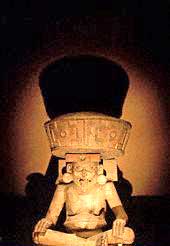
Rain God
Tlaloc Honouring Maice God Cinteotl |

Rain God
Tlaloc |
"....In her pictorial
depictions, the goddess, whose name means "Lady of Waters," was
usually shown wearing a jade skirt decorated with conch shells....
turquoise earrings and a necklace of jade or other blue-green stones
from which hung a golden medallion.... Her pictorial depictions
often showed her wearing a crown of serpents or otherwise adorned
with them, indicating her being one of the serpent gods of the
Mexicans.
"Was Teotihuacan laid out and constructed as some kind of a
waterworks, employing water for some technological processes? Before
we answer the question, let us mention another puzzling discovery
there.
"Alongside the third segment down from the Pyramid of the Sun,
excavations of a series of interconnected subterranean chambers
revealed that some of the floors were covered with layers of thick
sheets of mica. This is a silicone whose special properties make it
resistant to water, heat, and electrical currents. It has therefore
been used as an insulator in various chemical processes and
electrical and electronic applications, and in recent times in
nuclear and space technologies.
"....According to expert opinions, the
mica found at Teotihuacan is
of a type that is found only in faraway Brazil. Traces of this mica
were also found on remains removed from the Pyramid of the Sun’s
stages when it was being uncovered early in this century. What was
the use to which this insulating material was put at
Teotihuacan?
"Our own impression is that the presence of the Lord and Lady of
Water alongside the principal deity, Quetzalcoatl; the sloping
avenue; the series of structures, subterranean chambers, tunnels;
the diverted river; the semi subterranean sections with their
sluices; and the underground compartments lined with mica - were all
components of a scientifically conceived plant for the separation,
refining or purification of mineral substances.
"....Who, besides the
gods, were the original dwellers of Teotihuacan? Who had carried the stones and mortar to raise its
first pyramids? Who had channeled the waters and operated the
sluices?
"Those who assume that Teotihuacan is no older than a
few centuries
B.C. have a simple answer: the Toltecs. Those who lean toward a much
earlier beginning have started to point to the Olmecs, an enigmatic
people who emerged in the Mesoamerican scene in the middle of the
second millennium B.C. But the Olmecs themselves pose many puzzles,
for they appear to have been black Africans; and that too is
anathema to those who simply cannot accept transatlantic crossing
millennia ago.
"....Circa 200 B.C. whoever had lorded over
Teotihuacan picked up
and left, and the place became a Toltec city.... Then, a thousand
years after they had drifted in, (centuries preceding the Christian
era) the Toltecs too packed up and left. No one knows why; but the
departure was total and Teotihuacan became a desolate place, living
only in memories of a golden past.
"Some believe that the event coincided with the establishment of
Tollan as the Toltecs’ new capital, circa A.D. 700.... The
rediscovery began toward the end of the nineteenth century....
confirmed not only the city’s existence but also its history as told
in various codices, especially the one known as Anales de Cuauhtitlan.
It is now known that Tollan was ruled by a dynasty of priest-kings
who claimed to have been descendants of the god Quetzalcoatl and
therefore, in addition to their given name, also bore the god’s name
as a patronym - a custom that was prevalent among the Egyptian
pharaohs.... In the second half of the tenth century A.D. the ruler
was Ce Acatl Topiltzin-Quetzalcoatl; his name and time are certain
because a portrait of his, accompanied by a date equivalent to A.D.
968, can still be seen carved on a rock overlooking the site of the
city.
"It was in this time that a religious conflict broke up out among
the toltecs; it seems that it concerned the demand by part of the
priesthood to introduce human sacrifices in order to pacify the
War
God. In A.D. 987 Topiltzin-Quetzalcoatl and his followers left
Tollan and migrated eastward, emulating the early legendary
departure of the divine Quetzalcoatl. They settled in Yucatan.
"Two centuries later natural calamities and onslaughts by other
tribesmen brought the Toltecs to their knees.... Thus it was that in
A.D. 1168 or thereabouts Tollan became a desolate city, left to
decay and disintegrate.
|

Carved Wall of
the Pyramid of the Feathered Serpent. |
Mr. Sitchin continues
describing in several subsequent paragraphs, the findings of
artifacts and studying the plans of the city, which was emulating
Teotihuacan. Major findings were also achieved in the 1940s under
Jorge R. Acosta.... Work was focused on the smaller pyramid that has
variably been referred to (at first) as Pyramid of the Moon, then as
Pyramid "B" and lately as the Qetzalcoatl Pyramid. The designation
stems primarily from the long native name for the mound that means
"Lord of the Morning Star," presumably one of the epithets of
Quetzalcoatl, and from the remain of colored plasterwork and low reliefs that adorned the pyramid’s stages, evidencing that its
decorations were dominated by the Featherd Serpent motif.
"The greatest archaeological treasure trove was found when the
Acosta teams realized that the northern side of this pyramid was
disturbed in pre-Hispanic times.... the archaeologists found a
trench, which was as high as the pyramid.... was used to bury in it
a great number of stone sculptures. When these were taken out, stood
up and fitted together, it became clear that these were sections of
the two round gateway columns, four square columns that are believed
to have held up the roof of the pyramid’s temple, and four colossal
humanlike statues, more than fifteen feet high that came to be known
as the Atlantes.... The facial features are not readily identifiable
and so far have defied comparison with any known racial group; but
although the four faces hold the same remote expression, a close
examination shows them to be slightly different and individual.
|
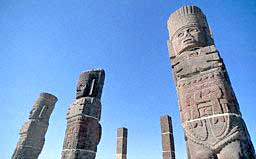
Atlantes
Statues at the Temple of the Morning Star
|
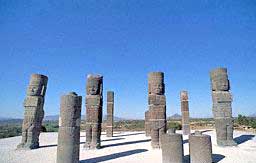
. |
"Whom do these
giant
statues represent? Their first discoverers called them "idols,"
certain that they represented deities. Popular writers nicknamed
them Atlantes, which implied both that they might have been
offspring of the Goddess Atlatona, "She Who Shines in the Water,"
and also that they might have come from the legendary Atlantis. Less
imaginative scholars see them simply as Toltec warriors, who hold in
their left hand a bunch of arrows, and an atl-atl (a curved spear or
arrow thrower) in the right hand. But this interpretation cannot
possibly be correct, for the "arrows" in the left hand are not
straight but curved; and we have seen that the left-handed weapon
was the atl-atl. At the same time, the weapon held in the right hand
is not curved as the atl-atl must be, what is it, then?
|

Detail
showing of Atlantes at the Temple of the Morning Star.
|

. |
"The instrument looks
rather like a pistol
(image below-left) in its holster held by two fingers. An
interesting theory suggesting that it was not a weapon but a tool, a
"plasma pistol," was advanced by Gerardo Levet (Mision Fatal). He
discovered that one of the square pilasters depicting Toltec
chieftains has, engraved in
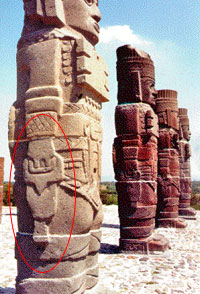 an upper left-hand corner, the
image of
a person wearing a backpack and holding the tool in question; he
uses it as a flame thrower to shape a stone. The tool is
unquestionably the same instrument held in the giants’ right hands.
Levet suggests that it was a high energy "pistol" that
used to cut
and carve stones, and he points out that such Thermo-Jet torches
were used in modern time to carve the giant monument of Georgia’s
Stone Mountain. an upper left-hand corner, the
image of
a person wearing a backpack and holding the tool in question; he
uses it as a flame thrower to shape a stone. The tool is
unquestionably the same instrument held in the giants’ right hands.
Levet suggests that it was a high energy "pistol" that
used to cut
and carve stones, and he points out that such Thermo-Jet torches
were used in modern time to carve the giant monument of Georgia’s
Stone Mountain.
"....On the other hand, the depicted tool may serve to explain
another enigmatic aspect of Tollan.
"....The
archaeologists (Acosta’s) discovered that the external and
visible pyramid was built over and hid an earlier pyramid whose
stepped stages lay some eight feet away on each side. They also
discovered remains of vertical walls that suggested the existence of
inner chambers and passages within the earlier pyramid (but have not
pursued these leads). They did come upon an extraordinary feature -
a stone pipe made of perfectly fitting tubular sections with an
inner diameter of about eighteen inches. The long pipe was installed
inside the pyramid at the same angle as its original incline and ran
through the whole height.... The position and incline of the
unusual, if not unique, tubular contraption was obviously
part of
the original plan of the pyramid and integral to the structure’s
purpose. The fact that the remains of the adjoining multichambered
and multistored buildings suggest some industrial processing, and
also the fact that in antiquity water from the Tula river was
channeled by these buildings, raise the possibility that at this
site, as at Teotihuacan, some kind of a purification and refining
process had taken place at a very early period.
"What comes to our mind is this: Was the enigmatic tool a tool not
to engrave stones, but to break up stones for their ores? Was it, in
other words, a sophisticated mining tool?
"And was the mineral sought after,
gold?
"....The fact that at some pre-Hispanic time the colossal images
were disassembled and carefully lowered into the depths of the
pyramid and buried there, implies a measure of sanctity. Indeed, it
all confirms the statement by Sahagun.... that when the
Toltecs
abandoned Tollan "they buried many things" some of which, even in
Sahagun’s time, "were brought up from under the ground and not
without admiration for their beauty and workmanship."
"....The
four Atlanteans stood atop the Pyramid of Quetzalcoatl,
supporting the ceiling of the temple atop the pyramid as though they
were holding up the Celestial Canopy. This is the role played in
Egyptian beliefs by the four sons of Horus, who were holding up the
sky at the four cardinal points. According to the Book of the Dead,
it was these four gods, who linked Heaven and Earth, who accompanied
the deceased pharaoh to a sacred stairway whereby he would ascend
heavenward for an eternal afterlife. This "Stairway to Heaven" was
depicted hieroglyphically as either a single or a double stairway,
the latter representing a step pyramid. Was it just a coincidence
that the stairway symbol decorated the walls around the
Tollan pyramid and became a major Aztec iconographic symbol?
|
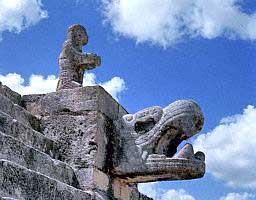
Mayan sculpture
of Winged Serpent. Human figure standing atop the head of a
Winged Serpent. Chichen Itza, Mexico. |
"....Quetzalcoatl (the
Nahuatl peoples’s hero-god), giver of all their knowledge, the
"Feathered Serpent." But what, one may ask, was a "feathered"
serpent if not a serpent that, birdlike, had wings and could fly?
"And if so, the concept
of Quetzalcoatl as the "Feathered Serpent" was non other than
the
Egyptian concept of the Winged Serpent that facilitated the
transfiguration of the deceased pharaoh to the realm of the
ever-living gods.
"In addition to Quetzalcoatl, the Nahuatl pantheon was
replete with
deities associated with serpents.
"....And so, unacceptable as this might be to pragmatic scholars,
mythology, archaeology, and symbolism led to the unavoidable
conclusion that Central Mexico, if not all of Mesoamerica, was
the
realm of the Serpent Gods - the gods of ancient Egypt.
Return
Chapter Four
SKYWATCHERS IN
THE JUNGLES
"Maya
"The Maya
mystique seized the imagination and curiosity of Europeans
from the moment the Spaniards first set foot in the Yucatan
peninsula and saw the vestiges of cities lost in the jungle.
"....With other interests in their minds, such as the search for
riches and the conversion of the natives to Christianity, it took
nearly two centuries for the Spaniards to turn their attention to
the ruins. It was only 1785 that a royal commission inspected the
then-discovered ruins of Palenque.
Lord Kingsborough, and
Landa have been an invaluable source of data
on the Maya past.
"But in the popular mind, the honor of launching the
archaeological
discovery of the Maya civilization belongs to a native of New
Jersey, John L. Stephens. Appointed U.S. envoy to the Central
American Federation, he went to the Maya lands with his friend
Frederick Catherwood, an accomplished artist.
"....The team’s reports were especially detailed regarding the great
sites of Palenque, Uxmal, Chichen Itza, and
Copan.... Of particular
importance was the realization that some of the symbols and glyphs
carved upon the monuments in fact stated the date thereof, so that
the Maya civilization could be placed in a time frame.
"....We could have known much more about
the Maya from their own
extensive literature - books that were written on paper made from
tree barks and laminated with white lime to create a base for the
inked glyphs. But these books, by the hundreds, were systematically
destroyed by the Spanish priests - most notable by the very same
Bishop Landa who ended up being the one who preserved much of the
"pagan’ information in his own writings.
"Only three (or, if authentic, a fourth)
codices ("picture books")
have remained. The parts scholars find most interesting in them are
the sections dealing with astronomy. Two other major literary works
are also available because they had been rewritten, either from
original picture-books or from oral traditions, into the native
tongues but using Latin script.
"One of these is the books of
Chilam Balam, meaning the
Oracles of Utterings of Balam the priest.... Balam, it appears, was a kind of a
Maya "Edgar Cayce"; the books record information regarding the
mythical past and the prophetic future, on rites and rituals,
astrology, and medical advice.
"The word balam means "jaguar" in the native tongue, and has caused
much consternation among scholars, for it has no apparent connection
with oracles. We find it intriguing, however, that in ancient Egypt
a class of priests called Shem-priests, who pronounced oracles
during certain royal ceremonies as well as secret formulas intended
to "Open the Mouth" so that a deceased pharaoh could join the gods
in the Afterlife wore leopard skins. Maya depictions of similarly
clad priests have been found; since in the Americas this would have
to be a jaguar skin rather than that of an African leopard, this
could explain the "jaguar" meaning of the name of
Balam. It would
also indicate, once more, an Egyptian ritual influence.
|
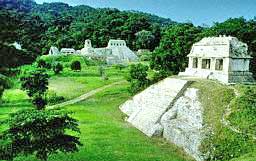
Palace and
Temples at Palenque |
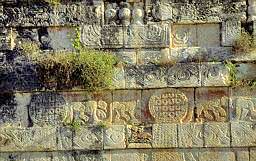
Wall on
Jaguar Temple at Chichen Itza |
|
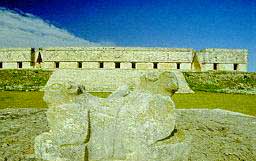
Jaguar
Sculpture At Uxmal Palace |
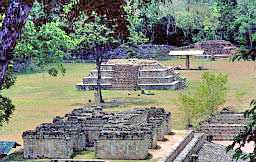
Mayan Ruins
at Copan, Honduras. |
"We are even more
intrigued by the similarity of this name of the Maya oracle-priest
to that of the seer Balaam, who, according to the Bible, was
retained by the king of Moab during the Exodus to put a curse on the
Israelites, but who ended up being pronounced their favorable
oracle. Was this just a coincidence?
"The other book is
the Popol Vuh, the "Council Book" of the
highland
Maya. It gives an account of divine and human origins and of royal
genealogies; its cosmogony and creation traditions are basically
similar to those of the Nahuatl peoples, indicating a common
original source. Regarding Maya origins
the Popol Vuh states that
their forefathers had come "from the other side of the sea."
Landa
wrote that the Indians "have heard from their ancestors that his
land was occupied by a race of people who came from the East and
whom God had delivered by opening twelve paths through the sea."
These statements are in accord with a Maya tale known as the
Legend
of Votan.... The legend relates the arrival in Yucatan, circa 1000
B.C. by the chronicler’s calculations, of "the first man whom God
had sent to this region to people and parcel out the land that is
now called America." His name was Votan (meaning
unknown); his
emblem was the Serpent. "He was descendant of
the Guardians, of the
race of Can. His place of origin was a land called Chivim." He made
a total of four voyages. The first time he landed he established a
settlement near the coast. After some time he advanced inland and
"at the tributary of a great river built a city which was the cradle
of this civilization." He called the city Nachan, "which means
Place
of Serpents." On his second visit he surveyed the newfound land
examining its subterranean zones and underground passages; one such
passage was said to have gone right through a mountain near Nachan.
When he returned to America the fourth time he found discord and
rivalry among the people. So he divided the realm into four domains,
establishing a city to serve as the capital of each. Palenque is
mentioned as one of them; another appears to have been near the
Pacific coast. The others are unknown.
"....Zelia Nuttal.... pointed out that
the Maya word for serpent,
Can, paralleled the Hebrew Canaan. If so, the Maya legend, telling
that Votan was of the race of Can and his symbol was the
serpent,
could be using a play of words to state that Votan came from Canaan.
This certainly justifies our wondering why Nachan, "Place of
Serpents," is virtually identical to the Hebrew
Nachash that means
"serpent."
"Such legends strengthen the scholarly school that considers the
Gulf Coast as the place where Yucatec civilization began - not only
of the Maya, but also of the earlier Olmecs. In this view much
consideration has to be given to a site that is little known to
visitors, which belongs to the very beginnings of Maya culture
"between 2000 and 1000 B.C. if not earlier," according to its
excavators from Tulane University - National Geographic Society.
Called Dzibilchalum, it is situated near the port city
Progreso on
Yucatan’s northwest coast. The remains, extending over an area of
twenty square miles, reveals that the city was occupied from the
earliest times through Spanish times, its edifices having been built
and rebuilt and overbuilt, and its cut and ornamented stones having
been hauled away to be used in Spanish and modern constructions near
and far. Besides immense temples and pyramids, the city’s
outstanding feature is a Great White Way, a cause way paved with
limestones that ran straight for a mile and a half as an east-west
axis to the city.
|

Cenote
Xlacah, Dzibilchaltun, Yucatan.
Used as an offering well. |

Temple of
the Seven Dolls, Dzibilchaltun
|
|
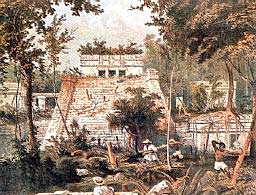
Castle at
Tulum overtaken by vegetation. From John Lloyd’s
Stephens Voyage to Yucatan, by Frederick Catherwood.
|
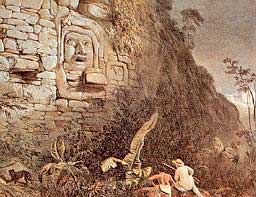
Head of
Itzanma at Izamal, from John Loyd’s Stephens Voyage to
Yucatan
.
|
"A string of major Maya
cities stretches across the northern tip of Yucatan, bearing names
well know not just to archaeologists but to millions of visitors:
Uxmal, Izamal, Mayapan, Chichen Itza, Tulum - to mention the most
outstanding sites. Each played a role in Maya history....
"Notwithstanding all this legendary and archaeological evidence,
another school of archaeologists believes that Maya culture - or at
least the Mayas themselves - originated in the southern highlands
(today’s Guatemala), spreading from there northward. Studies of the
Maya language trace its origin to a "a proto-Maya community that,
perhaps around 2600 B.C. existed in what is now the departments of
Huehuetenango in northwest Guatemala." (D.S. Morales,
The Maya World).
|

Miners Quarrying
Stone, Huehuetenango,
Highlands, Guatemala. |
"But wherever and
however Maya civilization developed, scholars consider the second
millennium B.C. as its "Pre-Classic" phase and the beginning of the
"Classic" phase of maximal achievement circa A.D. 200; by
A.D. 900
the realm of the Maya extended from the Pacific coast to the Gulf of
Mexico and the Caribbean.... And then, five centuries before the
Spanish arrival, for reasons unknown, the Maya abandoned their
sacred cities and let the jungle take them over.
"Palenque, one of the earliest
Maya cities.... its fame and allure
took off only after the discovery in 1949 (by Alberto Ruiz Lhuillier)
that the stepped pyramid called the Temple of Inscriptions contained
a secret internal stairway that led all the way down. Several years
of excavation and removal of the soil and debris that fell and hid
the inner structure yielded in the end a most exciting discovery: a
burial chamber. At the bottom of the twisting stairway a triangular
stone block masked an entranceway through the blank wall that was
still guarded by the skeletons of Maya warriors. Behind there was a
vaulted crypt, its walls painted with murals. Within, a stone
sarcophagus was covered by a large rectangular stone slab that
weighs about five tons and is 12 1/2 feet long. When this stone lid
was moved, there came into view the skeletal remains of a tall man,
still bedecked with pearls and jade jewelry. His face was covered
with a mosaic jade mask; a small jade pendant bearing the image of a
deity lay among the beads that once were a jade collar.
"The discovery was astounding, for until then no other pyramid or
temple in Mexico had been found to have served as a tomb. The enigma
of the tomb and its occupant was deepened by the depiction carved
upon the stone lid:
was the image of a
barefoot Maya sitting upon a plumed or flaming
throne and seemingly operating mechanical devices inside an
elaborate chamber. The Ancient Astronaut Society and its sponsor,
Erich Von Daniken, have seen in this a depiction of an astronaut
inside a spacecraft driven by flaming jets. They suggest that an
Extraterrestrial is buried here.
|
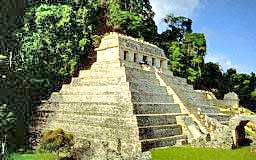
Temple of
Inscriptions, Palenque |
"Archaeologists and
scholars ridicule the idea. Inscriptions of the walls of this
funerary edifice and in adjoining structures convince them that the
person buried here is the
ruler Pacal ("Shield") who reigned in
Palenque in A.D. 615-683. Some see in the scene a depiction of the
deceased Pacal being taken by the Dragon of the Underworld to the
realm of the dead; they consider the fact that at the winter
solstice the Sun sets exactly behind the Temple of Inscriptions as
added symbolism of the king’s departure with the setting Sun God.
Others, prompted to revised interpretations by the fact that the
depiction is framed by a Sky Band, a chain of glyphs that represent
celestial bodies and the zodiac constellations, regard the scene as
showing the king being carried by the Celestial Serpent to the
celestial realm of the gods. The crosslike object that the deceased
is facing is now recognized as a stylized Tree of Life, suggesting
that the king is being transported to an eternal afterlife.
"In fact a similar tomb, known as
Burial 116, was discovered in the
Great plaza of Tikal, at the foot of one of its major pyramids.
|
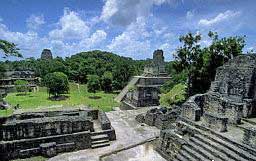
Tikal Great
Plaza,
Guatemala
|
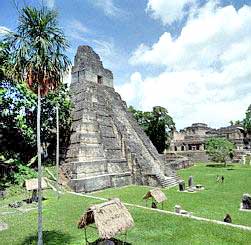 |
"....All considered,
scholars have admitted that "one cannot avoid an implicit comparison
to the crypts of the Egyptian pharaohs. The similarities between the
tomb of Pacal and those who ruled earlier beside
the Nile are
striking" (H. La Fay "The Maya, Children of Time" in the
National
Geographic Magazine). Indeed, the scene on Pacal’s sarcophagus
conveys the very same image as that of a pharaoh transported, by the
Winged Serpent, to an eternal afterlife among the gods who came from
the heavens. The pharaoh who was not an astronaut, had become one
upon his death; and that, we suggest, is what the carved scene has
implied for Pacal.
"....The construction of an
airstrip near Tikal’s ruins speeded up
its exploration after 1950 and extensive archaeological work has
been conducted there especially by teams from the University Museum,
University of Pennsylvania. They discovered that the great plazas of Tikal served as a
necropolis, where rulers and noblemen were buried;
also, that many of the lesser structures were in fact funerary
temples, built not over the tombs but next to them and serving as
cenotaphs. They also uncovered about one hundred and fifty stelas,
carved stone slabs erected mostly so as to face either east or west.
They depict, it was ascertained, portraits of actual rulers and
commemorate major events in their lives and reigns. The hieroglyphic
inscriptions carved upon them recorded accurate dates associated
with these events, named the ruler by his hieroglyph (here "Jaguar
Paw Skull," A.D. 488) and identified the event; the textual
hieroglyphs, scholars are by now certain, were not merely pictorial
or ideographic "but also written phonetically in syllables similar
to those of Sumerian, Babylonian, and Egyptian" (A.G. Miller,
Maya
Rulers of Time).
"....But as ongoing discoveries and excavations have shown, site
after new site in Guatemala, Honduras, and
Belize indicates the
existence of monuments and dated stelas as early as 600 B.C.,
revealing a developed system of writing that , all scholars agree,
must have had a prior developmental phase or source.
"Students of the
Maya civilization have been especially impressed by
the accuracy, ingenuity and diversity of Maya time reckoning,
attributing them to an advanced Maya astronomy.
"The
Maya had, indeed, not one but three calendars, but one - the
most significant one in our opinion - had nothing to do with
astronomy. It is the so called Long Count. It stated a date by
counting the number of days that had passed from a certain starting
day to the day of the event recorded by the Maya on the stela or
monument. The enigmatic Day One, most scholars now agree,
was August
13, 3113 B.C. according the current Christian calendar - a time and
an event that clearly preceded the emergence of the Maya
civilization.
Mr. Sitchin at this point explains the "vigesimal system" (times
twenty). Then continues:
"....But, as stated, in their
actual calendrical dating on their
monuments, the Maya went back not to the age of the dinosaurs but to
a specific day, an event as crucial to them as the date of Christ’s
birth is to the followers of the Christian calendar. Thus Stela 29
at Tikal, which bears the earliest date so far found on a royal
monument there (A.D. 292), gives the Long Count date of a total of
1,243, 615 days.
"Dividing the 1,243,615 days by the number of days in a solar year,
364 1/4, the date on the stela states that it, or the event depicted
on it, occurred 3,404 years and 304 days after the mysterious Day
One; i.e., since August 13, 3113 B.C. Therefore, according to the
now accepted correlation, the date on the stela is A.D. 292 (3,405 -
3,113 = 292). Some scholars see evidence that the Maya began to use
the Long Count in the era of Baktun 7, which equaled the fourth
century B.C.; others do not dismiss an even earlier use.
|
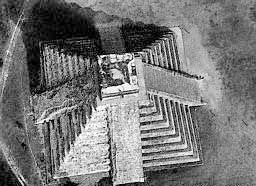
Castillo
Temple-Pyramid. It might have symbolized the Maya Calendar
Haab, Chichen Itza, Yucatan. |
"Alongside this
continuous calendar there were two cyclical calendars. One was the
Haab or Solar Year of 365 days that was divided into 18 months of 20
days, plus an additional 5 days at year’s end.
"The other (cyclical calendar) was
the Tzolkin or Sacred Year
calendar in which the 20 basic days were rotated 13 times, resulting
in a Sacred Year of 260 days. The two cyclical calendars were then
meshed together, as though they were gear wheels driven by each
other to create the grand Sacred Round of 52 solar years; for the
combination of 13, 20, and 365 could not repeat itself except once
in 18, 980 days, which equals 52 years. This Calendar Round of 52
years was sacred to all the peoples of ancient Mesoamerica and they
related to it events both past and future - such as the messianic
expectation of the return of Quetzalcoatl.
"The
earliest Sacred Round date was found in Mexico’s
Oaxaca valley
and goes back to 500 B.C. Both time reckoning systems, the
continuing one and the Sacred Round one, are quite old. One is
historical, continuing the passage of time (days) from an event in
the long-ago whose significance and nature are still a puzzle. The
other is cyclical, geared to a peculiar period of 260 days; scholars
are still trying to guess what, if anything, happened or still
happens once every 260 days
|
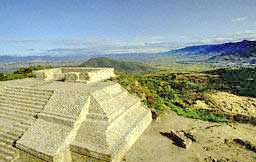
Pyramid on Mt.
Alban overlooking Oaxaca Valley, Mexico. |
"Some believe that this
cycle is purely mathematical.... Others suggest that the period of
260 days had to do with agriculture.... In view of the Mayan
propensity for astronomy, others attempt to somehow calculate a
relationship between 260 days and the motions of Venus or Mars. One
must wonder why a solution offered by Zelia Nuttal at the Twenty
Second International Congress of Americanists (Rome, 1926) did not
gain the full recognition it deserves. She pointed out that the
easiest way for the people of the New World to apply seasonal
movements of the Sun to their own locality was to determine Zenith
Days, when the Sun passed precisely overhead at midday. This happens
twice a year as the Sun appears to travel northward, then southward,
passing overhead twice. The Indians, she suggested, measured the
interval between the two Zenith Days and the resulting number of
days became the basis for the Calendar Round.... The interval was
precisely 260 days at latitude 14 degrees 42’ north - the
latitude of
Copan.
"....Copan was consider the
astronomical capital of the Maya.
Besides the usual celestial orientation of its edifices, some of its
stelas have been found to be aligned for determining key calendar
dates.
"....The reputation of the Maya as accomplished astronomers has been
enhanced by the fact that their various codices contain astronomical
sections dealing with solar and lunar eclipses and the planet Venus.
Closer study of the data revealed, however, that these were not
records of observations by the Maya astronomers. Rather, they were
almanacs copied from some earlier sources that provided the Maya
with ready-made data against which they were to look for phenomena
applicable to the 260-day cycle....
"The main task of the local astronomers, it appears, was to keep
verifying or adjusting the 260-day sacred year against data from
earlier times that dealt with the movements of celestial bodies.
Indeed, the most renown and still standing observatory in Yucatan,
the Caracol in Chichen Itza, has frustrated successive researchers
who have tried, in vain, to find in its orientation and aperture
viewlines to the solstices or equinoxes. Some viewlines, however, do
seem to be related to the Tzolkin 260-day cycle.
|

El Caracol, Maya
Observatory at Chichen Itza, Yucatan, Mexico .
|
"The number 260 appears
to have been an arbitrary, deliberate choice; the explanation that
it results from multiplying a natural number, 20 (the number of
fingers and toes), by 13 only shifts the problem to the question,
Why and Wherefrom 13? The Long Count too contains an arbitrary
number, 360; inexplicably it abandons the pure vigesimal progression
and, after the kin (1) and uinal (20), introduces the
tun (360) into
the system. The Haab calendar also considers 360 as its basic
length, dividing this number into 18 "months" of 20 days; it rounds
off the year by the addition of 5 "bad days" to complete the solar
cycle of 365.
"All the three calendars thus are based on
numbers that are not
natural, numbers deliberately selected. We will show that both 260
and 360 reached Mesoamerica from Mesopotamia - via
Egypt.
"We are all familiar with the number 360: it is the number of
degrees in a circle. But few know that we owe the number to the
Sumerians, and that it stems from their sexagesimal ("Base 60")
mathematical system. The first known calendar was the Nippur
Calendar of the Sumerians; it was devised by dividing the circle of
360 into 12 parts, twelve being the sacred celestial number from
which followed the twelve months of the year, the twelve houses of
the zodiac, the twelve Olympian gods, and so on. The problem of the
shortfall of 5 1/4 days was solved by intercalation - the addition
of a thirteenth month after the passage of a number of years.
|

The Twelve Signs
of the Zodiac. |
"....The Sumerian
imprint on the Egyptian and hence the Mesoamerican
calendars was not
limited to the sexagesimal number 360. Various studies, principally
by B.P. Reko, in the early issues of El Mexico Antiguo, leave little
doubt that the thirteen months of the Tzolkin calendar
were in fact
a reflection of the 12-month system of the Sumerians plus the
thirteenth intercalary month, except that in Egypt ( and hence in
Mesoamerica) the thirteenth month had shrunk to an annual 5 days.
The term tun for 360 meant in the Maya language "celestial," a star
or planet within the zodiacal band. Interestingly, a "heap of stars"
- a constellation - was called Mool, virtually the same term
MUL that the Sumerians had used to mean "celestial body."
"The association of the Mesopotamian calendar with the Old World
will become additionally evident as we look at the most sacred
number, 52, to which all the great Mesopotamian events were geared.
The many attempts to explain it (like the statement that it is 13
times 4) ignore its most obvious source: the 52 weeks of the Near
Eastern calendar ( and thereafter the European one). This number of
weeks, however, is arrived at only if a week of 7 days is adopted.
This was not always the case. The origin of a 7-day week has been a
subject of study for almost two centuries and the best theory is
that it derived from the four phases of the Moon. What is certain is
that it emerged as a divinely decreed time period in biblical times,
when God commanded the Israelites during the Exodus from Egypt to
observe the seventh day as the Sabbath.
|
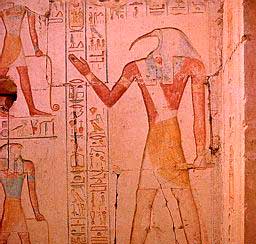
Relief of Thoth
at Abydos |
"....Although a deity
whose epithet was "Seven" was a principal Sumerian god, he was
honored with theophonic place (e.g., Beer-Sheba, The Well of Seven)
or personal names Elisheva, (My God is Seven) principally in the land
of Canaan. The number 7 as a revered number appears in the tales of
the Hebrew patriarchs only after Abraham went to Egypt and stayed at
the pharaoh’s court. The number 7 permeates the biblical tale of
Joseph, the pharaoh’s dream and the ensuing events in Egypt. And, to
the extent that 52 stemmed from the consideration of 7 as a basic calendrical unit, we will show that
this most sacred cycle of
Mesoamerica was of Egyptian origin.
"More specifically: 52 was a magical number that was associated with
the Egyptian god Thoth, the god of science, writing, mathematics,
and the calendar.
Mr. Sitchin ends this chapter by telling the
tale of Satni-Khamois:
"The Adventures of
Satni-Khamois with the Mummies"
....son of a pharaoh, "was well instructed in all things." He was
wont to wander in the necropolis of Memphis (then the capital). He
was in search of a book that the god Thoth had written with his own
hands, "in which are revealed the mysteries of the Earth and the
secrets of the Heavens...."
Satni had to remove the book, which was in a box of gold, inside a
box of silver, that was inside a series of other boxes, the last and
outer ones being of bronze and iron, from a Pharaoh’s tomb, the
pharaoh was Nenoferkheptah ("scholars believe , that he reigned
circa 1250 B.C.), who although buried with his sister-wife and their
son, they were not dead but in suspended animation, they could see,
hear, and speak, this was a curse placed on them by Thoth when
Nenoferkheptah stole the book.
When Satni finally arrived to the tomb, even having been warned of
the dangers, and as he was approaching the Pharaoh’s feet, where the
boxes with the book was, he entered in a dialogue, and a warning,
with Nenoferkheptah:
"There was a way to possess the book without incurring
Thoth’s
wrath, he said: it was to play and win the Game of Fifty-Two, the
magical number of Thoth."
Satni agreed. Unfortunately he lost the first and subsequent games,
sinking in the ground a bit further down as he lost each game.
|

First and Second
Pyramids of Giza. Ancient Memphis; by Luigi Mayer .
|
"How he managed to
escape with the book, the calamities that befell him as a result,
and how he in the end returned it to its hiding place , make up the
rest of this ancient version of "Raiders of the Lost Ark."
"The tale’s moral was
that no man, as knowledgeable as he might be, could learn the
mysteries of the Earth, the Sun, the Moon, and the planets without
divine permission; unauthorized by Thoth, Man will lose the Game of
Fifty-Two. And he would lose it even if he tried to find out the
secrets by opening up the protective layers of Earth’s minerals and
metals.
"It is our belief that it was the same Thoth,
Alias Quetzalcoatl,
who had bestowed the Calendar of Fifty-Two, and all other knowledge,
upon the peoples of Mesoamerica. In Yucatan the Maya called him
Kukulcan; in the Pacific regions of Guatemala and
El Salvador he was
called Xiuhtecuhtli; the names all mean the same: Feathered or
Winged Serpent.
|

Stairs up
Kukulcan, Chichen Itza, Yucatan, Mexico |

Crowds at
Solstice in Kukulcan |
"At first temples were
lofted atop step pyramids to worship the Serpent God, and the skies
were observed to watch for the key celestial cycles. But there came
a time when the god - or all the celestial gods - had left. Seen no
more, they were presumed to have been swallowed by the ruler of the
night, the jaguar; and the image of the great god was hencefore
covered by the jaguar’s mask, through which the serpents, his
erstwhile symbol, still emerge.
"But had no Quetzalcoatl promised to return?
"Fervently the skywatchers of the jungles consulted ancient
almanacs. Priests advanced the notions that the vanished deities
would return if offered the throbbing hearts of human victims.
"But at some crucial calendrical date in the ninth century A.D., a
prophesied event failed to occur. All the cycles came together, and
added up to naught. And so were the ceremonial centers and the
deities dedicated to the gods abandoned, and the jungle cast its
green mantle over the domain of the Serpent Gods.
Return
|











 an upper left-hand corner, the
image of
a person wearing a backpack and holding the tool in question; he
uses it as a flame thrower to shape a stone. The tool is
unquestionably the same instrument held in the giants’ right hands.
Levet suggests that it was a high energy "pistol" that
used to cut
and carve stones, and he points out that such Thermo-Jet torches
were used in modern time to carve the giant monument of Georgia’s
Stone Mountain.
an upper left-hand corner, the
image of
a person wearing a backpack and holding the tool in question; he
uses it as a flame thrower to shape a stone. The tool is
unquestionably the same instrument held in the giants’ right hands.
Levet suggests that it was a high energy "pistol" that
used to cut
and carve stones, and he points out that such Thermo-Jet torches
were used in modern time to carve the giant monument of Georgia’s
Stone Mountain. 



















